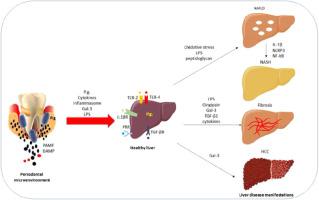Environmental Toxicology and Pharmacology ( IF 4.2 ) Pub Date : 2021-10-16 , DOI: 10.1016/j.etap.2021.103755 Devaraj Ezhilarasan 1

|
Periodontitis is a most prevalent and infectious multifactorial inflammatory disease and is characterized by the progressive destruction of the tooth-supporting tissues. Porphyromonas gingivalis, a Gram‑negative oral anaerobe, mainly causes periodontitis and it is one of the most important risk factors responsible for aggravation of existing systemic diseases. Several experimental and clinical studies have shown the positive association between periodontitis and different forms of liver disease. Periodontal diseases increase the prevalence of non-alcoholic fatty liver diseases and cirrhosis. Infected periodontium and pathogens in the periodontal microenvironments release pathogen-associated molecular patterns such as peptidoglycan, lipopolysaccharides, gingipain, fimbria, bacterial DNA, etc, and damage-associated molecular patterns such as interleukins-1α, β, − 8, and galectin-3, etc. These virulence factors and cytokines enter the bloodstream, disseminate into the whole body, and induce a variety of systemic pathological effects, including liver diseases (steatosis and fibrosis). Maintaining oral hygiene by scaling and root planning significantly improves liver damage in patients with periodontitis. Dentists and physicians should have more awareness in understanding the bidirectional nature of the relationship between oral and systemic diseases. Importantly, periodontitis condition aggravates simple fatty liver into fibrotic disease and therefore, the aim of this review is to understand the possible link between periodontitis and liver diseases.
中文翻译:

解读牙龈卟啉单胞菌衍生内毒素在肝脏疾病中的毒理学作用
牙周炎是一种最普遍和传染性的多因素炎症性疾病,其特征是牙齿支持组织的进行性破坏。牙龈卟啉单胞菌是一种革兰氏阴性口腔厌氧菌,主要引起牙周炎,是导致现有全身性疾病恶化的最重要危险因素之一。多项实验和临床研究表明,牙周炎与不同形式的肝病之间存在正相关关系。牙周病增加了非酒精性脂肪肝和肝硬化的患病率。受感染的牙周组织和牙周微环境中的病原体释放病原体相关分子模式,如肽聚糖、脂多糖、牙龈蛋白酶、菌毛、细菌 DNA 等,以及损伤相关分子模式,如白细胞介素-1α、β、-8 和半乳糖凝集素-3等。这些毒力因子和细胞因子进入血液,传播到全身,并诱发多种全身病理作用,包括肝脏疾病(脂肪变性和纤维化)。通过洗牙和牙根规划来保持口腔卫生可显着改善牙周炎患者的肝损伤。牙医和医生在理解口腔疾病和全身疾病之间关系的双向性方面应该有更多的认识。重要的是,牙周炎会使单纯的脂肪肝恶化为纤维化疾病,因此,本综述的目的是了解牙周炎和肝脏疾病之间可能存在的联系。











































 京公网安备 11010802027423号
京公网安备 11010802027423号